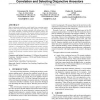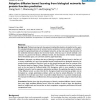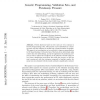56 search results - page 8 / 12 » Recognition of Binding Patterns Common to a Set of Protein S... |
BMCBI
2006
13 years 7 months ago
2006
Background: Members of a protein family often have highly conserved sequences; most of these sequences carry identical biological functions and possess similar three-dimensional (...
CIKM
2005
Springer
14 years 1 months ago
2005
Springer
Many bioinformatics applications would benefit from comparing proteins based on their biological role rather than their sequence. In most biological databases, proteins are alrea...
ICAPR
2005
Springer
14 years 1 months ago
2005
Springer
There is need for more formal specification of recognition tasks. Currently, it is common to use labeled training samples to illustrate the task to be performed. The mathematical ...
BMCBI
2008
13 years 7 months ago
2008
Background: Machine-learning tools have gained considerable attention during the last few years for analyzing biological networks for protein function prediction. Kernel methods a...
CORR
2006
Springer
13 years 7 months ago
2006
Springer
Fitness functions based on test cases are very common in Genetic Programming (GP). This process can be assimilated to a learning task, with the inference of models from a limited n...




